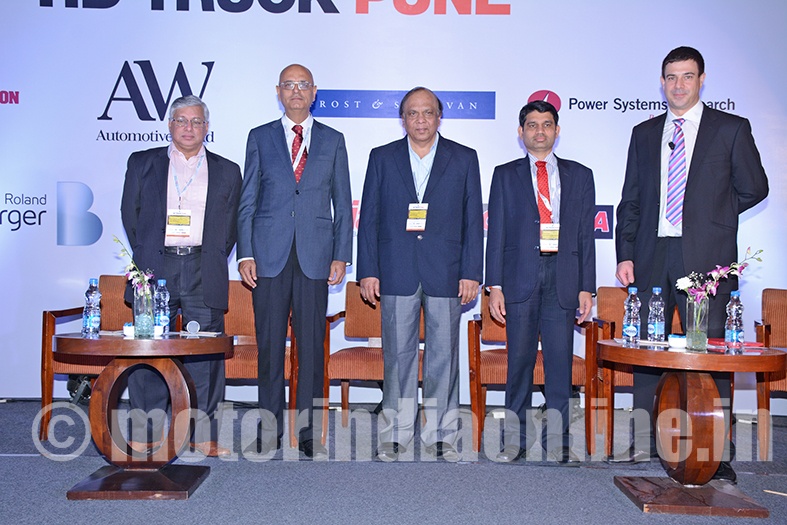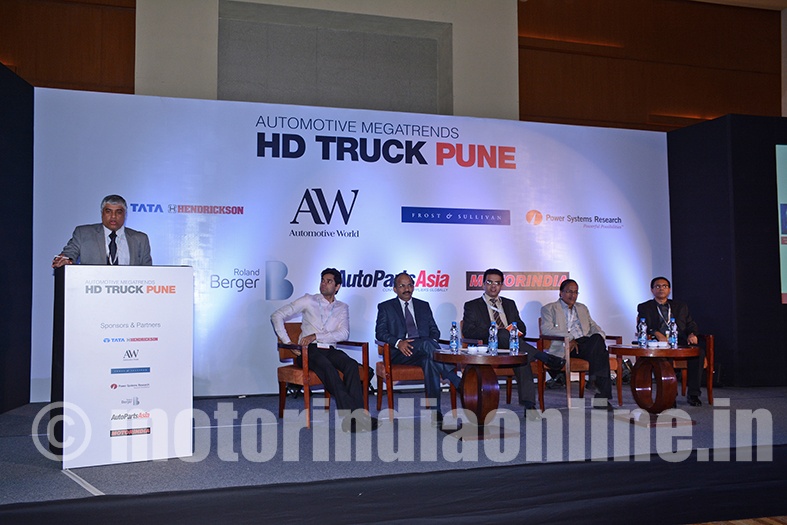Focus on digitization, regulatory changes and technology advancements
The Automotive Megatrends HD Truck Conference in Pune recently brought together the stakeholders responsible for the evolution and sustenance of the Indian commercial vehicle industry. The day kick-started with a keynote address by Mr. Sunny Manjani, Consultant, Mobility (Automotive and Mobility) Practice at Frost & Sullivan that provided an overview of the commercial vehicle market in India.

He said: “HCV sales have recovered in the last two years due to positive outlook and lower fuel prices, coupled with continuing discounts provided by major OEMs. Growth in higher GVW vehicles is more than the lower GVW range in each sub-segment like 31 tonnes and 37 tonnes. Rigid has grown more than 25 tonnes-rigid and 40 tonnes tractor has grown more than 35 tonnes tractor segment. Regulatory changes like GST, emission norms, safety parameters and vehicle scrapping policy will further drive the change.”
Impact of digitisation and GST
Every industry will have to adapt to digitization and freight brokerage will not remain oblivious to it. Flexibility, mobility and real-time demand will result in faster technology adoption. The Frost and Sullivan report that Sunny presented stated that Indian long haul freight transportation market is estimated to be $136 billion in 2016, 25 per cent of this is through brokers providing a significant opportunity for digital freight brokerage solutions. Increase in e-eommerce and Internet penetration in India along with urbanization and GST will further proliferate the hub-and-spoke model; the B2B space can also be tapped in addition to B2C space.
“Freight brokerage will change due to mobile-based freight brokerage tools, better capacity utilization in last-mile transport services and just-in-time deliveries will improve efficiency. Demand for logistics will change owing to retailers minimizing the cost by reducing storage and inventory stocks. This will result in higher demand being placed on integrated supply chain and partnerships for flexible deliveries and also integration of IT like telematics and data-driven route planning and load assignments,” informed Mr. Manjani.

The keynote address was followed by the panel discussion featuring Mr. Nalin Mehta, MD and CEO, Mahindra Truck and Bus, Mr. Ravindra Pisharody, Executive Director, Commercial Vehicles, Tata Motors, Mr. A. Ramasubramanian, President, AMW Motors, and Mr. B. Srinivas, Senior Vice President – Strategy and Product Planning, VE Commercial Vehicles.
The session moderated by Mr. Martin Kahl, Editor, Automotive World, aimed at predicting the key megatrends which look set to shape the country’s truck and bus industry over the next 10 years and beyond.
Mr. Ramasubramanian stated: “The Indian truck segment, and particularly the value segment, will see a lot of technological changes in the next 10 years than it saw in the last 50 years. The trigger to the change would be fossil fuel engines, the predominance on auto cycle engine, the mechanical part of engines becoming less and less relevant as we move forward. Electrics, hybrid will come and the challenge here in India will be that as we are growing towards the peak of conventional trucks, we will also see being attacked by trucks with superior technology. Instead of fuel, combustion and mechanics the trucks will be measured also by other aspects like data, connectivity and analytics device available.”
Mr. Nalin Mehta, MD and CEO, Mahindra Truck and Bus, drawing comparisons to the car industry, said: “Like how the car industry changed in terms of regulation, entry of global players, technology and something similar will be witnessed by the truck industry in the next decade. GST will also pave way for a lot of changes. It will be a big encouragement for the transporters to become productivity oriented from the cost-saving orientation mode that they work in. GST will push transporters to adopt turn-around time (TAT) and total cost of ownership. GST is just the beginning, and there are other reforms and regulatory changes like driver comfort, BS-VI emission norms and in other aspects of the trucks waiting in the wings to change.”
Mr. Ravindra Pisharody seconded Mr. Mehta’s views calling GST as the catalyst for other changes to trickle in. He said: “The most visible form of positives from the GST is the fact that it promises uninterrupted movement of vehicles across States and guarantees uptime of the vehicle resulting in productivity. It will also mean that companies in trucking industries can do away with multiple warehouses. If today a manufacturer has 35 – 40 thousand warehouses due to high value items, it will be cheaper to have a local warehouse than spend more on far-flung warehouses. Therefore, one of the biggest beneficiaries of GST will be the logistics industry.”
Speaking about the impact of GST on global investments in India, Mr. B. Srinivas said: “It is quite a challenge to maintain logistics business today as the waiting time costs a transporter approximately 30 paisa per tonne per kilometer, so if he is earning Rs. 2 per tonne per km, he is losing around 15 per cent. So with GST if the efficiency improves the bottomline too can improve. It will open up opportunities both for manufacturers as well as the transporters. It will also attract a lot of foreign direct investments as it will be much easier to business in our country.”
Improving CVs
In addition to the panel discussion, there were interesting presentations made by speakers from companies, including Modine Thermal Systems, Taco Hendrickson, Omnicomm, Shell Lubricant, etc. Mr. Jerry Kapoor, MD, Modine Thermal Systems, said: “By 2025 developed countries are targeting Nox reduction by 75 per cent and PM (particulate matter) reduction by 1/10. Power train cooling with CV radiators and E-Fan cooling will play a significant role in fuel efficiency and emission trends.”
Speaking about fuel economy lubricant, Mr. Akhil Jha, VP – Technical, Shell Lubricant India, observed: “We have been testing our fuel economy lubricant for the last 3-4 years and have conducted successful evaluation to achieve a result of around 3 per cent vis a vis an average of 6-7 per cent of fuel economy that people get in the market. It covered both off-highways and highway vehicles. We are speaking to fleet operators and making them aware of our product as well as the total cost of ownership.”
Mr. Mohit Mehrotra, VP and Business Head – India and SAARC Omnicomm, spoke about the usage and relevance of telematics. He said: “Our fuel consumption control system can help improve assets productivity. Besides fuel pilferage, an inefficient refueling operation can reduce availability of important mining trucks and impact productivity. Our fuel dispatching system automatically checks fuel hours and matches hauling units with the fuel location that will get it fuelled the soonest. This will reduce interruption of operations, stop unnecessary refuelling, reduce wait time at fuel bay and quantify metrics for fueling efficiency and use them to improve.”
Mr. Sanjay Sinha, CEO, Taco Hendricson, spoke about improving customer experience through light, reliable and durable suspension systems. “Our emphasis is more on developing a diverse range of products, both to support our existing customers and cater to new customers. We believe in creating the right kind of products to cater to each of the requirements of the Indian CVs, be it truck, trailer or tipper or even bus. Our quest of improving our offering will only help improve the entire CV industry.”